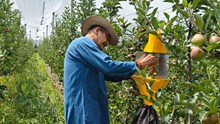
Most farmers in Sonbhadra, Mirzapur, Chandauli, and surrounding districts have quietly relied on goats to support their families. Of all livestock, goats are referred to as the ‘poor man's cow,’ and with good reason, they eat less feed, can thrive in local weather conditions, and breed rapidly.
The Sonebhadri goat, named after the district of Sonbhadra. It is a local breed that is familiar to goat farmers across this region. These goats are not only strong but also emotionally attached to the families that raise them. The goats are left for grazing by women and children from the village, and most farmers say they are "as much part of the family as the children."
What Makes the Sonebhadri Goat Special?
These goats are typically brown or black in color. They have flat leafy ears, spiral horns, and short curled up tails that present them with a unique identity. Males reach up to 30 to 32 kilograms in weight, while females weigh 28 to 30 kilograms under good conditions.
They are well suited to the dry, hilly, and forest-rich terrain of the Vindhyan plateau. Their hard hooves and resistance to diseases make them best suited for farmers who cannot afford expensive medicines and feeds. Most goats give birth to first kids at 15 months of age, and twinning is common following the first pregnancy. They are calm in nature and are easily handled by women, old farmers, and children.
Goat Rearing Best Practices: Easy, Local, and Efficient
1. Housing
In villages, farmers usually build kutcha goat shelters using mud walls and thatched roofs. This traditional setup works well, but some things should be kept in mind. Proper ventilation is essential to prevent heat buildup. The floor must remain dry and slightly raised to prevent water from collecting. Pregnant goats and young kids should be kept separately to avoid crowding and injuries.
2. Feeding
Sonebhadri goats are natural grazers. They wander about 4 to 5 kilometers every day, grazing on grasses, leaves, and bushes in the forest. Grazing contributes largely to their diet and so they are low-maintenance animals to keep.
But, specially during pregnancy and while lactating young ones, goats require special attention. Wheat bran, broken pulses, or ensiled fodder such as wheat straw and maize stalks can be fed to them. Clean water should always be provided, preferably tube wells/hand pumps. Most farmers proclaim proudly, "Our goats eat what we don't. They clean the field and return strong."
3. Breeding
Most of the goats in this region naturally breed between the monsoon months from May to July when there is adequate green fodder. Healthy buck goats, locally called "biju bakra", should be chosen with care. Select those having strong legs, good eating capacity, and active nature.
Don't use the same buck for members of the family or immediate relatives to avoid inbreeding. Sharing breeding bucks with neighboring communities is a good and easy means of ensuring healthy genetic diversity. A good buck can keep 20 to 25 females if properly managed.
4. Health Care
Sonebhadri goats are disease-resistant in nature, but following some simple practices will make them healthy throughout the year. Deworming needs to be carried out every three to four months with ordinary veterinary tablets. Vaccination with PPR (goat plague) and foot-and-mouth disease is necessary, particularly in regions where these diseases have been prevalent in the recent past.
Maintaining the cleanliness and dryness of the goat shed, regular removal of manure, and avoiding overcrowding can prevent many diseases in the making. The majority of diseases in goats are brought about by damp floors, filthy water, or inadequate shelter all of which can be controlled with caution and vigilance.
Why Goat Farming is Profitable for Small Farmers
Sonebhadri goats are a very good option for poor rural families. Their feed cost is minimal since they depend largely on grazing. Goats at the age of 8 to 10 months can be sold and generate instant and frequent income. Goats also give good manure quality, which enhances the soil fertility for the farmer's own production.
Even though their milk production is low, some goats can still supply enough milk for home consumption. In time, farmers can choose females with superior milking capacity if dairy usage is wanted.
Challenges and Easy Fixes
A frequent challenge is shortage of feed in the dry summer season. This problem can be addressed by storing crop residues such as wheat straw and maize stalks during the harvest time.
The second challenge is restricted access to veterinary care in far-flung villages. An effective solution is to organize farmer groups and invite mobile veterinary camps from the block or district headquarters.
Production of milk is usually low in such goats, as it is natural. However, if the farmer wishes to concentrate on milk, then culling and selective breeding of improved milking females can be done.
Preserving a Local Treasure: Why Sonebhadri Goats Must Be Saved
These goats are not mere cattle, they are a part of local identity and diversity. These goats are locally adapted to climate, disease-resistant, and do not need special fodder. By continuing to breed and enhance Sonebhadri goats, farmers are contributing to the preservation of a distinct breed that has been of service to their forefathers for generations.
Research centers such as ICAR-CIRG are also trying to research and perhaps officially acknowledge this breed, which can result in further support and improved prices in the future. But for now, it is the farmers themselves who are the real keepers of this local breed.
For small and marginal farmers, goat farming is not just about profit , it’s about survival, dignity, and tradition. Starting with five to ten goats is enough. Keep basic records of breeding, health, and growth. Attend village training programs when possible and share your learning with others. The Sonebhadri goat is more than just an animal. It's a companion during difficult times, a symbol of tenacity, and a leap toward a brighter future for all agricultural families in the Vindhyan region.
















